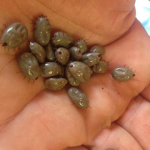Caring for Lizards
All native reptiles are protected and you may need a license to keep any in captivity. It is illegal to keep exotic (non-Australian) reptiles in captivity.
The following species do not require a permit:
- Centralian blue-tongued Lizard Tiliqua multifasciata
- Central Netted Dragon Ctenophorus nuchalis
- Central Bearded Dragon Pogona vitticeps
Housing your lizard
If your lizards are still young you will need to keep them inside.
1 meter aquarium is suitable.
Cover the floor with large gravel (they may eat small gravel and can become ill), and then provide hiding places (a pile of leaves and bark, a terracotta pot or a hollow log).
Add a shallow water dish that can’t be tipped over.
Ensure that the cage is kept dry, as these lizards do not do well in humid environments.
Lightning and Heating for your lizard
Many problems with keeping reptiles can be traced back to not providing the proper environmental conditions, particularly heat and light. Reptiles specifically require UV light.
The equipment to provide the proper heat and light to captive reptiles is often quite expensive, but is absolutely essential to keeping pet reptiles healthy.
UV light can be provided by special reptile UV lights, or by allowing the lizards access to direct unfiltered sunlight for at least 30 minutes daily.
Heating should be provided at one end of the cage, creating a temperature gradient between 20ºC and 30ºC. At this hot end, a perch can be provided, allowing the lizard to get even warmer if it desires. Make sure it cannot directly touch the heat source, or burns may result.
Blue or red lights, although a little cooler, can be used to provide heat at night.
Food
Most lizards are carnivorous, meaning that they would eat another animals or insects. Lizards should be fed daily. You can use specialized dry Lizard food available from Pet Shops, plus fresh fruit, vegetables and insects to add dietary variety. Feed a variety of greens, sweet potatoes, carrots, split peas, and green beans. Fruit should be offered sparingly. When feeding them be sure that the food given is chopped small, and are given in variety.
General care
Your lizard will slough its skin several times each year. The skin will appear dull, and then start to look opaque. Be very careful handling your lizard at this stage, as the new skin underneath can be quite fragile. Providing a rock or rough piece of bark for the lizard to rub against can be helpful.
If the skin does not shed completely, try soaking your lizard in warm water for 10 minutes and then gently pull the skin clear. Never force this process, and if soaking your lizard never leave it unattended in the water. Make sure your lizard stays healthy. It should have overall cleanliness, and should not be skinny, but well fleshed. If your lizard feels limp in your hand it is probably sick.
Constantly check your lizard’s stomach for burrs. Your lizard’s eyes should be clear, watch out for crust around the eyes. Another sign of sickness is runny nose. Your lizard’s mouth should be healthy pink. Pale pink greyish yellow are signs of sickness.


